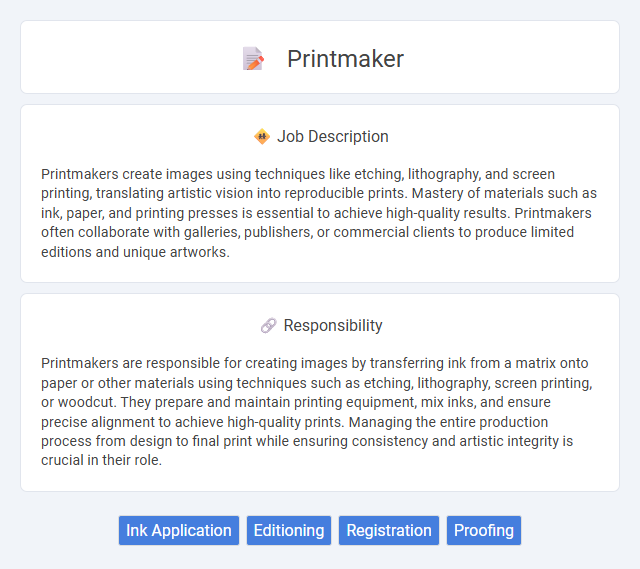
Printmakers create images using techniques like etching, lithography, and screen printing, translating artistic vision into reproducible prints. Mastery of materials such as ink, paper, and printing presses is essential to achieve high-quality results. Printmakers often collaborate with galleries, publishers, or commercial clients to produce limited editions and unique artworks.
People with strong attention to detail and patience are likely suitable for a printmaker job, as it involves precise techniques and careful handling of materials. Individuals who thrive in repetitive tasks and enjoy working with their hands may find this role fulfilling. Those who prefer fast-paced environments or extensive social interaction might not find printmaking as compatible with their work style.
Qualification
A successful printmaker requires strong artistic abilities, proficiency in various printmaking techniques such as etching, lithography, and screen printing, and a thorough understanding of color theory and materials. Formal education in fine arts or printmaking, often at the bachelor's degree level, combined with hands-on experience in a studio environment, enhances technical skills and creative expression. Attention to detail, patience, and knowledge of digital design tools like Adobe Illustrator and Photoshop also contribute significantly to professional printmaking quality.
Responsibility
Printmakers are responsible for creating images by transferring ink from a matrix onto paper or other materials using techniques such as etching, lithography, screen printing, or woodcut. They prepare and maintain printing equipment, mix inks, and ensure precise alignment to achieve high-quality prints. Managing the entire production process from design to final print while ensuring consistency and artistic integrity is crucial in their role.
Benefit
Printmakers likely enjoy the benefit of creative expression through various traditional and digital techniques, allowing them to produce unique artworks with personal or commercial value. They may experience flexible work environments, often balancing studio time with project collaborations, which can enhance job satisfaction. Financially, skilled printmakers could find consistent demand for limited editions and commissioned works, potentially providing a stable income stream.
Challenge
Printmakers likely face the challenge of mastering complex techniques that require precision and patience, as even minor errors can affect the final artwork. They may encounter difficulties balancing creativity with the technical demands of various printing processes, such as etching, lithography, or screen printing. The probability of overcoming these hurdles depends on continuous practice, adaptability, and a strong attention to detail.
Career Advancement
Printmakers can advance their careers by mastering various printing techniques such as screen printing, lithography, and etching to increase their artistic versatility and marketability. Building a strong portfolio and networking within art communities and galleries enables access to commissions, exhibitions, and collaborations with designers or industries. Many printmakers expand into teaching workshops or running their studios, leveraging expertise to establish brand recognition and passive income streams.
Key Terms
Ink Application
Printmakers specialize in applying ink with precision to various surfaces, utilizing techniques such as screen printing, lithography, and etching to create detailed and vibrant artwork. Mastery in ink viscosity, consistency, and layering ensures optimal transfer and durability of prints. Expertise in choosing appropriate inks--oil-based, water-based, or solvent-based--directly influences the texture, finish, and longevity of the final print.
Editioning
Editioning is a critical process in printmaking that involves creating a limited number of high-quality prints from a single plate or design, ensuring consistency and authenticity. Printmakers carefully number and sign each print in the edition to guarantee its value and collectibility, often adhering to industry standards that limit the edition size. Mastery in editioning requires precision, attention to detail, and thorough knowledge of printmaking techniques to maintain the integrity and uniqueness of each print.
Registration
Printmakers specialize in creating images by transferring ink from a matrix onto a surface, requiring precise registration to align multiple layers accurately. Registration ensures that each color or layer in a print aligns perfectly, preventing overlaps or gaps that could compromise the artwork's quality. Mastery of registration techniques is essential for producing detailed, multi-colored prints with sharp, consistent results.
Proofing
Proofing in printmaking ensures color accuracy and detail precision by creating test prints before the final edition. This process involves evaluating proofs for consistency in ink application, registration, and paper quality, crucial for maintaining high standards. Skilled printmakers use proofing to detect imperfections early, enabling adjustments that guarantee each print meets the intended artistic vision.
 kuljobs.com
kuljobs.com